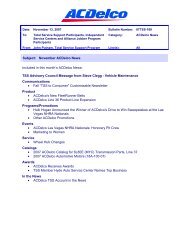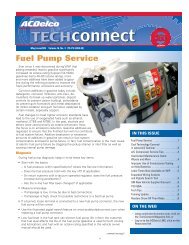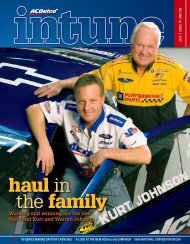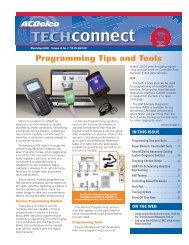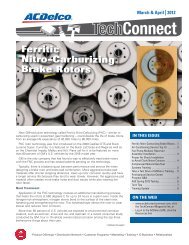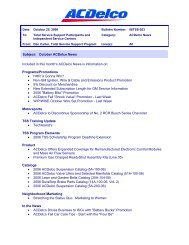You're Saving. - ACDelco TechConnect
You're Saving. - ACDelco TechConnect
You're Saving. - ACDelco TechConnect
You also want an ePaper? Increase the reach of your titles
YUMPU automatically turns print PDFs into web optimized ePapers that Google loves.
sErvicE bay<br />
18<br />
A HEAD START ON THE FUTURE<br />
As part of gM, <strong>ACDelco</strong> enables a unique opportunity for technicians to look under<br />
the hoods of fuel-cell vehicles<br />
Monroe County, N.Y., holds a unique position in the<br />
automotive world. The city of honeoye falls—located<br />
about halfway between Rochester and the finger Lakes<br />
area — is home to one of gM’s advanced powertrain<br />
technology laboratories, and nearby communities and<br />
municipalities in the county have become real-world<br />
proving grounds for the emerging technologies.<br />
County-owned vehicles, for example, include gM’s hybrid<br />
sedans and trucks, along with bio-diesel-, CNg- and<br />
E85/E20 ethanol-powered vehicles. Monroe County is<br />
also home to one of the nation’s few hydrogen refueling<br />
stations that is used to replenish the fuel supply of<br />
fuel-cell vehicles.<br />
With so much alternative-fuel activity in the area, there’s<br />
considerable interest from local technicians and other<br />
automotive professionals about the impact such<br />
technology may have on their businesses in the future.<br />
And when <strong>ACDelco</strong> representative george Matic ran<br />
into gM fuel-cell engineer David Savage at the grocery<br />
store, an idea was hatched for a summit meeting that<br />
would give local technicians an overview education on<br />
the nuts and bolts of fuel-cell vehicles.<br />
It all came together recently, as Matic collaborated with<br />
warehouse distributor Nu-Way Auto Parts and officials<br />
from Monroe County to conduct the one-of-a-kind<br />
seminar. David Savage and another representative from<br />
the honeoye falls lab were the featured speakers.<br />
“There is a lot of interest from technicians who want to<br />
get a handle on this upcoming technology,” says Mark<br />
Szwarcberg, market area service manager for <strong>ACDelco</strong>.<br />
“When the word went out about the seminar, we got an<br />
immediate and enthusiastic response.”<br />
About 100 local TSS, Key fleet and ISC technicians, as<br />
well as other automotive specialists, attended the event<br />
that was hosted at Monroe County’s fleet maintenance<br />
facility in Chili, N.Y. Savage walked the attendees through<br />
the design, operation and performance characteristics of<br />
hydrogen fuel-cell-powered vehicles.<br />
gM brought prototype fuel-cell vehicles based on<br />
modified versions of the Chevrolet Equinox. The vehicles<br />
were part of gM’s recent Project Driveway program that<br />
placed them with cities and individuals around the country<br />
for real-world evaluation. Seminar attendees were given<br />
the opportunity to ride the vehicles, but not surprisingly,<br />
their interests were really piqued when Savage put one<br />
of the Equinoxes on a lift and allowed the mechanically<br />
minded technicians to examine its unique features.<br />
“There wasn’t a person left in his seat when that vehicle<br />
was raised on the lift,” says Szwarcberg. “Everyone<br />
wanted to see if there were going to be radical differences<br />
in the way they worked on vehicles of the future. I think<br />
they were pleasantly surprised to find it wasn’t alien<br />
technology and servicing these vehicles won’t be radically<br />
different from today’s cars.”<br />
That the seminar came together with the assistance<br />
from engineers and prototype vehicles is a testament to<br />
the unique relationship shared between <strong>ACDelco</strong> and<br />
general Motors.<br />
“I don’t think you’d see such a unique program come<br />
together without that relationship,” says Szwarcberg.<br />
Bill Yandow, from Rochester, New York-based Nu-Way<br />
Auto Parts, agrees. “The gM lab is tied in very well locally,<br />
so it was great that we were able to leverage their<br />
engineers for the seminar.”<br />
Nu-Way Auto Parts often partners with <strong>ACDelco</strong> for local<br />
technician programs and seminars. The parts distributor<br />
supports TSS shops and <strong>ACDelco</strong>’s Key fleet customers,<br />
and coincidently, one of Yandow’s customers is the fleet<br />
department for Monroe County.<br />
“When they heard about the plans for the fuel-cell seminar,<br />
they insisted on hosting it at their facility,” says Yandow.<br />
“Because they are already using alternative-fuel vehicles,<br />
they wanted to play an integral part in the event.”<br />
Yandow reports the fuel-cell seminar was one of the<br />
most popular events staged by Nu-Way Auto Parts and<br />
<strong>ACDelco</strong>.<br />
“It was a great instance of synergy, when all the right<br />
elements came together for a very informative meeting,”<br />
he says. “It’s something that would only happen with<br />
<strong>ACDelco</strong> and its relationship with gM.”<br />
by Barry Kluczyk photos courtesy of general Motors<br />
HOW A FUEL-CELL<br />
VEHICLE WORKS<br />
A hydrogen fuel-cell-powered<br />
vehicle uses an electrochemical<br />
process to produce electricity<br />
from hydrogen. No petroleum<br />
products are used in a fuel-cell<br />
vehicle and the only “exhaust” is<br />
clean water vapor.<br />
Basically, each fuel cell consists<br />
of an electrolyte and a pair of<br />
catalyst-coated electrodes, a<br />
porous anode and cathode.<br />
hydrogen (or a hydrogen-rich fuel)<br />
is fed to the anode where the<br />
catalyst separates the hydrogen’s<br />
negatively charged electrons from<br />
the positively charged ions. At the<br />
cathode, oxygen combines with<br />
electrons, resulting in water or<br />
hydroxide ions.<br />
The electrons of the anode side<br />
SERVICE BAY<br />
of the cell cannot pass through the<br />
electrolyte to the positively charged<br />
cathode side. They must travel around it<br />
via an electrical circuit. This movement<br />
is the electrical current that is used to<br />
drive the vehicle. There is no internal<br />
combustion engine or conventional<br />
transmission, as the electric power is<br />
sent to electric motors at each wheel. n<br />
19



